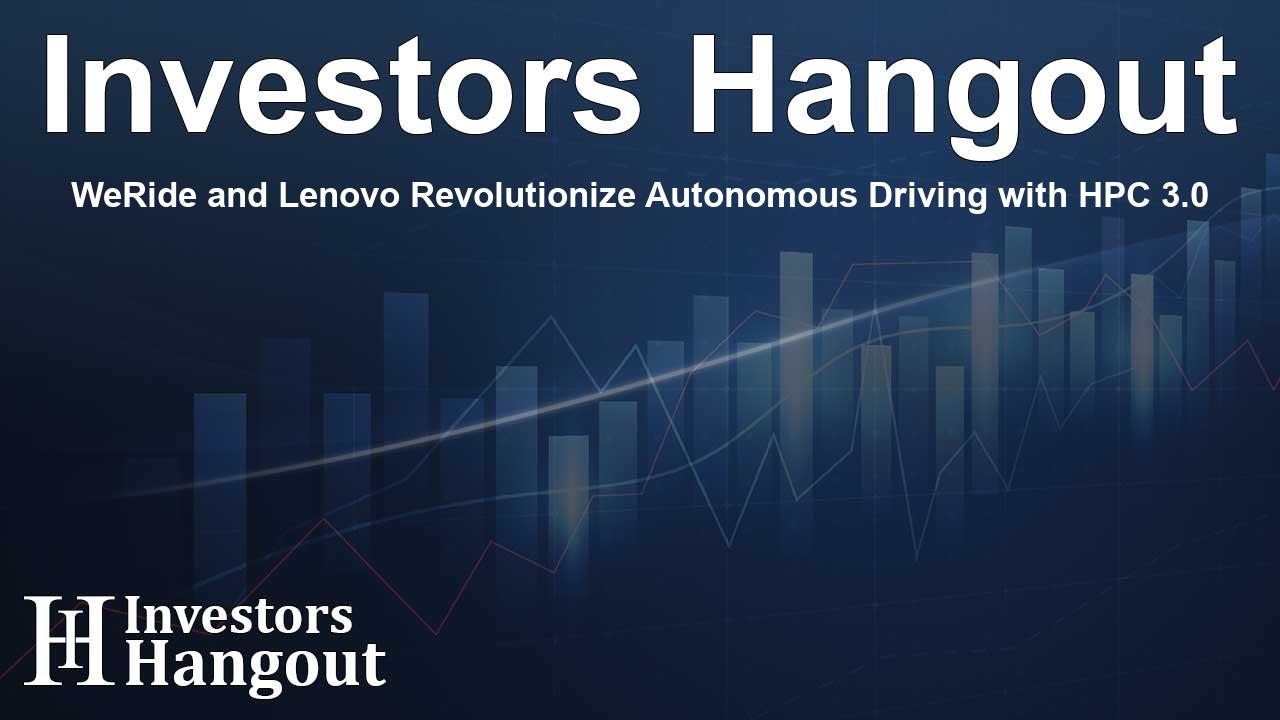WeRide and Lenovo Revolutionize Autonomous Driving with HPC 3.0

WeRide Unveils Innovative HPC 3.0 Platform with Lenovo
In an exciting development for the autonomous driving sector, WeRide, a prominent player in the industry, has launched its high-performance computing (HPC) 3.0 platform. This groundbreaking initiative, made possible through collaboration with Lenovo, showcases cutting-edge technology powered by NVIDIA's advanced DRIVE AGX Thor chips. The HPC 3.0 platform is integrated into WeRide's latest generation of Robotaxis, known as the GXR, marking an important milestone as the world's first mass-produced Level 4 (L4) autonomous vehicle utilizing this state-of-the-art computing platform.
Pioneering Autonomous Vehicle Technology
WeRide's HPC 3.0 is not just another computing platform; it is designed to elevate the potential of autonomous vehicles significantly. By incorporating a dual NVIDIA DRIVE AGX Thor configuration and the safety-certified DriveOS, the platform offers unmatched computational power, reaching up to 2,000 TOPS (trillions of operations per second). This unparalleled capability positions it as the most powerful computing solution geared towards supporting L4 autonomy, empowering vehicles to function autonomously and safely in urban environments.
Cuts in Production and Maintenance Costs
A key advantage of the HPC 3.0 platform is its ability to streamline production processes. By integrating key modules like the Ethernet gateway and collision detection systems, WeRide has realized a dramatic reduction in mass production costs, achieving up to a 75% decrease compared to the previous HPC 2.0. Additionally, the collaborative effort results in a reduction of autonomous driving suite costs by 50%, significantly lowering the total cost of ownership (TCO) by an impressive 84% over its lifetime.
Built for Reliability and Safety
The HPC 3.0 platform is engineered to meet the highest safety standards, holding certifications such as AEC-Q100, ISO 26262, and IATF 16949. Its architecture is designed with redundancy to ensure robust operation under critical conditions, achieving a remarkable failure rate of less than 50 FIT (failures per billion hours). Built to withstand extreme temperatures ranging from -40°C to 85°C, this platform promises longevity and reliability over a span of 10 years or 300,000 kilometers, facilitating dependable performance in various environments.
Strategic Collaboration Enhances Innovation
WeRide's close partnership with Lenovo and NVIDIA signifies a monumental leap in autonomous driving technology. As Tony Han, WeRide's Founder and CEO, stated, this collaboration has not only enhanced the reliability of the Robotaxi but has also reduced deployment costs significantly. The vision is clear: expand this innovative platform across WeRide's fleet, which includes models like the Robobus and Robosweeper, to bring smart and accessible mobility to cities worldwide.
Industry Impact and Future Prospects
This step towards innovation does not go unnoticed. Lenovo's senior executives emphasize their commitment to facilitating the commercialization of autonomous driving solutions globally, reinforcing the vital role of partnerships in achieving significant milestones. NVIDIA's continued investment in WeRide also underscores the potential of this technology to reshape urban mobility and make autonomous transportation safe and efficient.
WeRide's Vision for Global Expansion
WeRide stands out as the world's first publicly traded Robotaxi company, having successfully operated its vehicles on public roads for more than 2,000 days. Boasting a presence in over 30 cities across 10 countries, WeRide is continuing to push the boundaries of autonomous technology through strategic global partnerships, ensuring that efficient and safe autonomous mobility is within reach for many.
Frequently Asked Questions
What is WeRide's HPC 3.0 platform?
The HPC 3.0 platform is a high-performance computing solution developed by WeRide in partnership with Lenovo, utilizing NVIDIA's DRIVE AGX Thor chips to enhance autonomous vehicle capabilities.
How does the HPC 3.0 platform affect autonomous vehicle costs?
The platform significantly lowers production costs by integrating key systems, achieving a reduction of up to 75% in manufacturing expenses and 50% in autonomous driving suite costs.
What safety standards does the HPC 3.0 platform meet?
HPC 3.0 is certified to several key standards, including AEC-Q100, ISO 26262, and IATF 16949, ensuring it meets the rigorous safety requirements for autonomous driving.
How does WeRide's Robotaxi GXR differentiate itself?
The Robotaxi GXR is the world's first mass-produced Level 4 autonomous vehicle, equipped with the HPC 3.0 platform, defining a new benchmark in autonomous driving technology.
What is WeRide's broader goal with autonomous technology?
WeRide aims to expand its Robotaxi fleet globally, providing safe, efficient, and accessible mobility solutions in urban settings across various countries.
About The Author
Contact Caleb Price privately here. Or send an email with ATTN: Caleb Price as the subject to contact@investorshangout.com.
About Investors Hangout
Investors Hangout is a leading online stock forum for financial discussion and learning, offering a wide range of free tools and resources. It draws in traders of all levels, who exchange market knowledge, investigate trading tactics, and keep an eye on industry developments in real time. Featuring financial articles, stock message boards, quotes, charts, company profiles, and live news updates. Through cooperative learning and a wealth of informational resources, it helps users from novices creating their first portfolios to experts honing their techniques. Join Investors Hangout today: https://investorshangout.com/
The content of this article is based on factual, publicly available information and does not represent legal, financial, or investment advice. Investors Hangout does not offer financial advice, and the author is not a licensed financial advisor. Consult a qualified advisor before making any financial or investment decisions based on this article. This article should not be considered advice to purchase, sell, or hold any securities or other investments. If any of the material provided here is inaccurate, please contact us for corrections.
